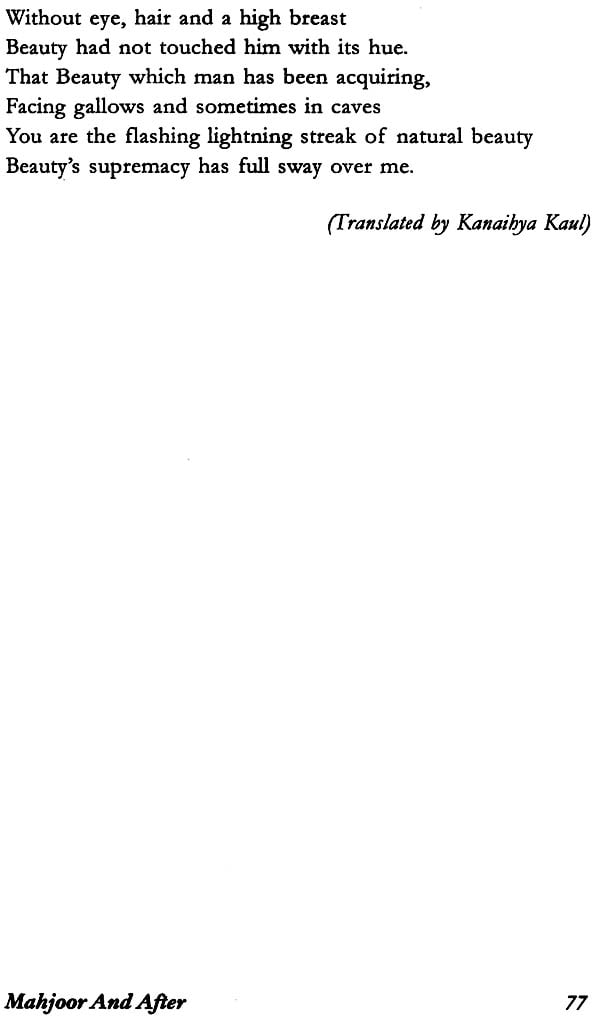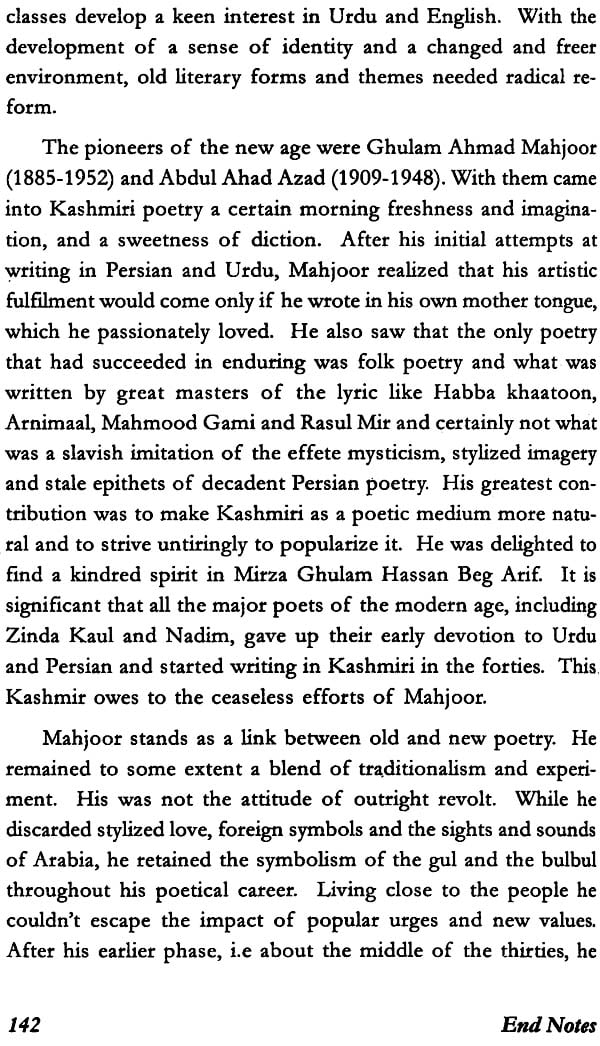
Mahjoor and After (An Anthology of Modern Kashmiri Poetry)
Book Specification
| Item Code: | NAJ062 |
| Author: | Trilokinath Raina |
| Publisher: | Sahitya Akademi, Delhi |
| Language: | English |
| Edition: | 2008 |
| ISBN: | 9788126025336 |
| Pages: | 157 |
| Cover: | Paperback |
| Other Details | 8.5 inch x 5.5 inch |
| Weight | 230 gm |
Book Description
About the Book
Mahjoor and after, the anthology we are presenting now is the outcome of the collective effort, embracing almost the whole of the 20th century, i.e. 1930-2000. It was designed originally to be only post-Independence poetry, but that would have excluded the best contributions of the pioneers of the new age, Zinda Kaul, Mahjoor and Azad, which were all written before 1947. Without them any anthology of the 20th century Kashmiri poetry would be incomplete for the aim has not been mere selection of poems but making the selection as comprehensive as possible.
What is being presented now, when the passion, for translating poetry has fairly caught on, is a collective endeavour, which has a distinct edge over all the poets rendered into English by only a single individual: it has the freshness of variety and absence of dull uniformity. This anthology is an attempt to introduce the reader to this new and rich harvest of Kashmiri poetry in English translation.
About the Author
Trilokinath Raina (b. 1922) retired as Professor of English from the National Defence Academy. He has brought out two books of translations: An Anthology of Modern Kashmiri Verse (1972) and the Best of Mahjoor (1989). He also has monographs on Dina Nath Nadim and Mahjoor along with A History of Kashmiri Literature published by Sahitya Akademi, to his credit.
Preface
The 20th Century, after its somnolent first quarter, was a period of turbulence and of great national and international importance : it witnessed the rise of the fascist powers, the holocaust of the Second World War and the growth of new tensions consequent upon our stepping into the Nuclear Age. In India, the gathering force of the Freedom Struggle moved on to its climatic phase and ushered in the era of Independence. In Kashmir, the feudal regime came to an end. These political changes led to a new awareness, a new awakening, a new urge to question the accepted, orthodox and traditional values in all fields of social activity. There was a socialist urge, a new desire to have a just society. Revolutionary ideas found more and more acceptance with the younger generation who were no longer deferential to taboos. There naturally was a breakdown of what had been regarded as stable moral values.
During the formative years, 1925-1955, the impact of the progressive movement was seen in all the regional literatures of India, with art becoming a vehicle of propaganda for social and political justice. Even the stage was no longer regarded as a place for providing mere entertainment but a school for political education. The significant writer was the self conscious artist, i.e, one who regarded socialist realism an all pervasive literary value.
And it is during these years of experiment and transition after well over fifty years of literary somnolence that the modern age in Kashmiri literature was born. The contribution of the pioneers, Mahjoor and Azad, not only in restoring to the Kashmiri language its lost prestige but also in infusing a new lyricism into poetry, was only one of the factors that were changing the milieu for the new writers. The apocalyptic change that came in Kashmir with 1947 led to the new poets setting their sights afresh and the emergence of Nadim as the new leader. The poet became the people's articulate voice against feudal rule, class exploitation, war and the imperialist designs on the valley of Kashmir. And there is no doubt that it was in this crucible of experiment with new forms and new themes that modern Kashmiri poetry had its new birth.
With the death of the progressive movement in the midfifties all over India came a decade of disillusionment and anger with brilliant satire naturally making their appearance in many of the poems of Mahjoor, Nadirn and others. When the despair had set in and the gods of progressivism had failed, the artists felt betrayed, and set their sights afresh for new artistic goals. They moved into the higher realms of mature theme, individual objective outlook and new experiments in form and metre. In a way Kashmiri poetry had a new birth altogether, and blossomed in many different ways, unknown earlier.
In spite of the multiplicity of the languages in India, there has always been a basic integrity in our country in the sphere of letters. Literature is a great force for global understanding and goodwill. It helps others to understand the culture of a people. Translations are thus of very great importance in promoting this understanding among various linguistic groups. The need for an anthology of Kashmiri poetry which would acquaint the outside reader with modern trends in our literature was long felt. Earlier, Prof J L Kaul, a pioneer in the true sense of the word, addressed himself to this task in the early forties and published Kashmiri Lyrics, an anthology of translations of a selection of Kashmiri lyrics written over the centuries. In 1971 Prof TN Raina came out with his contribution in this field An Anthology of Modern Kashmiri Verse, which covers three decades from 1930 to 1960. What is being presented now, when the passion for translating poetry has fairly caught on, is a collective endeavour, which has a distinct edge over all the poets rendered into English by only a single individual : it has the freshness of variety and absence of dull uniformity.
Sahitya Akademi with the help of University of Kashmir organised a Translation Workshop in which members of the faculty and other lovers of Kashmiri poetry were encouraged and helped to translate their favourite modern poems. The anthology we are presenting now is the outcome of that collective effort, embracing almost the whole of 20th century i.e., 1925-2000. It was designed originally to be only post Independence poetry, but that would have excluded the best contributions of the pioneers of the new age, Zinda Kaul, Mahjoor and Azad, and without which any anthology of the 20th century Kashmiri poetry would be incomplete.
Contents
| PREFACE | 9 |
| POEMS | 12 |
| ZINDA KAUL | |
| Ferry me across | 13 |
| Ghazal | 17 |
| Unpreparedness | 19 |
| GHULAM AHMAD MAHJOOR | |
| Why is my love cross with me | 21 |
| The peasant lass | 23 |
| Narcissus | 25 |
| I offer you my life | 27 |
| Freedom | 28 |
| ABDUL AHAD AZAD | |
| Satan's complaint | 29 |
| Change | 30 |
| Ghazal | 32 |
| The river | 33 |
| ABDUL AHAD ZARGAR | |
| Through disbief to belief | 37 |
| You will rue for ever | 39 |
| I'll cradle thee in my arms | 41 |
| An arrow pierced my heart | 43 |
| GHULAM RASOOL NAZKI | |
| Rubaaiyat | 45 |
| MIRZA GHULAM HASAN BEG ARIF | |
| Rubaaiyat | 47 |
| NOOR MOHAMMAD ROSHAN | |
| Spring | 50 |
| DINA NATH NADIM | |
| I will not sing today | 52 |
| On the death of a comrade | 56 |
| I dream of tomorrow | 58 |
| Blade of grass | 62 |
| Sugar candy and wormwood | 63 |
| Incidents | 65 |
| GHULAM NABI FIRAQ | |
| To the bulbul | 67 |
| Phantoms of the night | 69 |
| The flight | 72 |
| Ghazal | 74 |
| Beauty's supremacy | 76 |
| MOHAMMAD AMIN KAMIL | |
| Zero bridge | 78 |
| The bright highway | 80 |
| Nilnag | 82 |
| Ghazal | 85 |
| Your coming | 87 |
| RAHMAN RAHI | |
| The fire and the psalms | 88 |
| Ghazal | 92 |
| Inklings from the dark | 93 |
| The womb of the ocean. | 95 |
| My love-sick maid | 98 |
| As she shook her jingling skirt | 100 |
| Be not averse to my plea, my love | 102 |
| VASUDEV REH | |
| The anguish | 103 |
| GHULAM RASOOL SANTOSH | |
| Bahri Taweel | 105 |
| GHULAM NABI KHAYAL | |
| At the frontier post | 108 |
| RASHID NAZKI | |
| The voice | 110 |
| The shadow | 111 |
| A feeling | 112 |
| GHULAM NABI GOWHAR | |
| Wisdom | 113 |
| Impact | 114 |
| Accountability | 116 |
| MUZAFFAR AZIM | |
| Poem I | 118 |
| Poem –II | 118 |
| SYED RASOOL POMPUR | |
| Basant katha | 119 |
| To my newborn babe | 122 |
| Ghazal-I | 124 |
| Ghazal-II | 126 |
| RADHEY NATH MASARRAT | |
| The liar | 128 |
| BIMLA'RAINA | |
| Vaakh | 129 |
| NASEEM SHAFAI | |
| Ghazal-I | 131 |
| I could never understand | 132 |
| A Fork in the road | 134 |
| A Storya lesson | 136 |
| Ghazal-II | 138 |
| Ghazal- III | 139 |
| Ghazal-IV | 140 |
| END NOTES FROM THE EDITOR | 141 |













